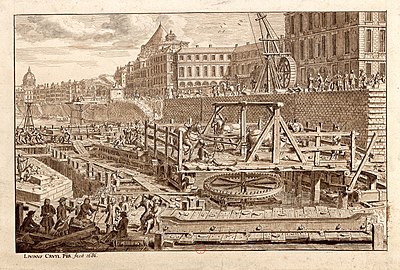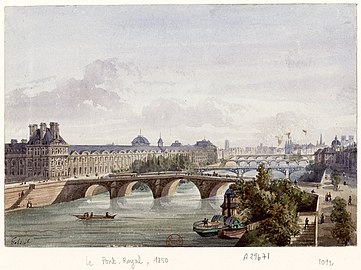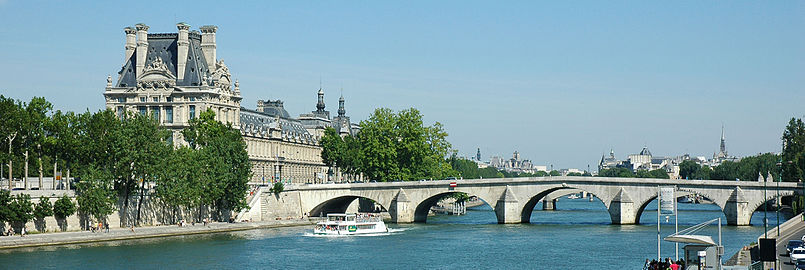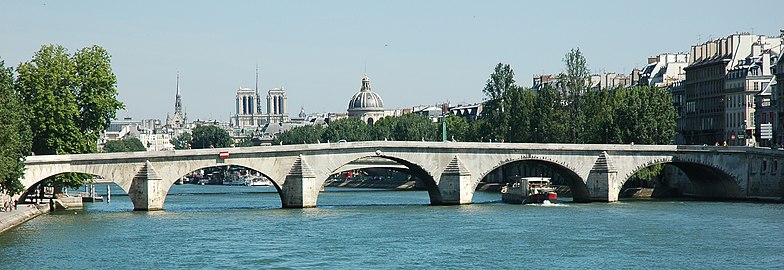Pont Royal: Difference between revisions
Lazulilasher (talk | contribs) m fixed categories |
Pinacotecus (talk | contribs) m Pont Royal |
||
| (73 intermediate revisions by 50 users not shown) | |||
| Line 1: | Line 1: | ||
{{Short description|Bridge}} |
|||
{{Infobox_Bridge |
|||
{{Infobox Bridge |
|||
| |
|name= Pont Royal |
||
|image= |
|image= Pont Royal 2009.jpg |
||
|caption= A photograph of the Pont Royal and the [[Left Bank]] taken in the evening. |
|||
| ⚫ | |||
|official_name= |
|official_name= |
||
|also_known_as= |
|also_known_as= |
||
|carries= Motor vehicles, pedestrians, and bicycles |
|carries= Motor vehicles, pedestrians, and bicycles |
||
|crosses= [[Seine|The Seine River]] |
|crosses= [[Seine|The Seine River]] |
||
|locale= [[Paris]], [[France]] |
|locale= [[Paris]], [[France]] |
||
|id= |
|id= |
||
|design= [[Arch Bridge]] |
|design= [[Arch bridge|Arch Bridge]] |
||
|length= |
|length= 110 m |
||
| ⚫ | |||
|width= 16m (53 feet) |
|||
|below= |
|below= |
||
| |
|begin= 1685 |
||
|complete= 1689 |
|||
|toll= Free both ways |
|toll= Free both ways |
||
|coordinates={{ |
|coordinates= {{coord|48|51|36.35|N|02|19|47.56|E|display=inline,title}} |
||
| ⚫ | |||
| ⚫ | |||
}} |
}} |
||
The '''Pont Royal''' is a [[bridge]] |
The '''Pont Royal''' is a [[bridge]] crossing the river [[Seine]] in [[Paris]]. It is the third oldest bridge in Paris, after the [[Pont Neuf]] and the [[Pont Marie]]. |
||
==Location== |
==Location== |
||
| ⚫ | The Pont Royal links the [[Rive Droite|Right Bank]] by the [[Pavillon de Flore]] with the [[Rive Gauche|Left Bank]] of Paris between [[rue du Bac]] and the [[rue de Beaune]]. The bridge is constructed with five elliptical arches ''en plein cintre''. A hydrographic ladder, indicating floods' highest level in Paris, is visible on the last pier nearest each bank. |
||
[[File:Musee d'Orsay and Pont Royal, North-West view 140402 1.jpg|600px|thumbnail|center|[[Musée d'Orsay]] and Pont Royal]] |
|||
| ⚫ | The Pont Royal links the [[ |
||
==Access== |
==Access== |
||
| Line 28: | Line 33: | ||
==History== |
==History== |
||
| ⚫ | In 1632, the entrepreneur [[Pierre Pidou]] directed the construction of a wooden toll-bridge which would be called ''Pont Sainte-Anne'' (in deference to [[Anne of Austria]]) or ''Pont Rouge'' (due to its color). It was designed to replace the Tuileries ferry upon which the [[rue du Bac]] (''bac'' meaning ''ferry'' in French) owes its name. The ferry had been offering crossings since 1550. Fragile, this bridge of fifteen arches would be repaired for the first time in 1649, completely redone two years later, burnt in 1654, flooded in 1656, completely rebuilt in 1660, propped up in 1673 and finally carried away by a flood in February 1684. [[Madame de Sévigné]] reported that this last incident caused the loss of eight of the bridge's arches. |
||
| ⚫ | |||
| ⚫ | In |
||
The bridge was finally reconstructed between 25 October 1685 and 13 June 1689, this time with [[masonry|stone]], receiving complete financing from King [[Louis XIV]]. It was the king who gave it the name ''Pont Royal''. [[François-Michel le Tellier, Marquis de Louvois|Louvois]], director of the [[Bâtiments du Roi]], charged [[Jacques Gabriel]], [[Jules Hardouin-Mansart]] and [[François Romain]] with the construction project. In the 18th century, the bridge was a popular meeting place for various festivities and celebrations. |
|||
| ⚫ | |||
| ⚫ | At the time of the [[French Revolution]] |
||
| ⚫ | At the time of the [[French Revolution]], in the period following the fall of the monarchy on 10 August 1792 and the beginning of the [[First French Empire]] in 1804 - the name of Pont Royal was changed to Pont National. During that period, General [[Napoleon|Napoléon Bonaparte]] (future Napoléon I, [[Emperor of the French]]) had cannons installed on the bridge in order to protect the [[Convention Nationale]] and the [[Committee of Public Safety]], housed in the [[Tuileries]] Palace. |
||
| ⚫ | |||
| ⚫ | |||
| ⚫ | |||
| ⚫ | |||
| ⚫ | |||
<br clear=all /> |
|||
| ⚫ | |||
{{clear}} |
|||
==Gallery== |
==Gallery== |
||
<gallery> |
<gallery mode=packed heights=180px> |
||
File:Paris-PontRoyal-1686.jpg|Construction of the bridge in 1686 |
|||
File:Paris-PontRoyal-1687.jpg|Construction of the bridge in 1687 |
|||
File:Le Pont Royal et le Pavillon de Flore, 1814 - BnF.jpg|The bridge and the [[Pavillon de Flore]] in 1814 |
|||
File:Paris-PontRoyal-1850.jpg|The Pont Royal in 1850 |
|||
File:Pont_Royal_vu_de_la_passerelle_Solférino-20050628.jpg|View from the [[Passerelle Solférino]] |
|||
File:Pont Royal and Musée d'Orsay, Paris 10 July 2020.jpg| Pont Royal and Musée d'Orsay |
|||
File:France_Paris_Pont_Royal_01.JPG |
|||
File:France_Paris_Pont_Royal_02.JPG |
|||
Image:France_Paris_Pont_Royal_03.JPG |
|||
File:France_Paris_Pont_Royal_04.JPG |
|||
</gallery> |
</gallery> |
||
== |
==See also== |
||
* [[List of crossings of the River Seine]] |
|||
| ⚫ | |||
| ⚫ | |||
==References== |
==References== |
||
<references /> |
|||
This article was mainly derived from the [ |
This article was mainly derived from the [[:fr:Pont Royal|French Article]] of the same name. |
||
== |
==External links== |
||
{{Commons category|Pont Royal}} |
|||
Bridge location on the Seine: |
|||
| ⚫ | |||
<table style="border: 1px solid #aaaaaa; background-color: #f9f9f9; padding: 0.8em; width: auto; margin-top: 0.1em; margin-bottom: 0.1em"> |
|||
<tr style="border: 1px"><td> |
|||
| ⚫ | |||
</td> |
|||
<td> |
|||
[[Image:Paris-Ponts-Royal.png]] |
|||
</td> |
|||
<td> |
|||
| ⚫ | |||
</td></tr> |
|||
</table> |
|||
| ⚫ | |||
| ⚫ | |||
[[Category:Bridges completed in the 1600s|Royal]] |
|||
[[Category:Official historical monuments of France|Royal]] |
|||
| ⚫ | |||
| ⚫ | |||
| ⚫ | |||
[[ |
[[Category:Deck arch bridges|Royal, Pont Royal]] |
||
[[ |
[[Category:Bridges over the River Seine in Paris|Royal, Pont Royal]] |
||
[[Category:Monuments historiques of Paris]] |
|||
[[ja:ロワイヤル橋]] |
|||
| ⚫ | |||
| ⚫ | |||
| ⚫ | |||
| ⚫ | |||
[[Category:Stone bridges in France|Royal, Pont Royal]] |
|||
| ⚫ | |||
| ⚫ | |||
[[Category:1632 establishments in France]] |
|||
Latest revision as of 14:25, 21 October 2021
Pont Royal | |
|---|---|
 Pont Royal | |
| Coordinates | 48°51′36.35″N 02°19′47.56″E / 48.8600972°N 2.3298778°E |
| Carries | Motor vehicles, pedestrians, and bicycles |
| Crosses | The Seine River |
| Locale | Paris, France |
| Next upstream | Pont du Carrousel |
| Next downstream | Passerelle Léopold -Sédar-Senghor |
| Characteristics | |
| Design | Arch Bridge |
| Total length | 110 m |
| Width | 17 m [1] |
| History | |
| Construction start | 1685 |
| Construction end | 1689 |
| Statistics | |
| Toll | Free both ways |
| Location | |
 | |
The Pont Royal is a bridge crossing the river Seine in Paris. It is the third oldest bridge in Paris, after the Pont Neuf and the Pont Marie.
Location[edit]
The Pont Royal links the Right Bank by the Pavillon de Flore with the Left Bank of Paris between rue du Bac and the rue de Beaune. The bridge is constructed with five elliptical arches en plein cintre. A hydrographic ladder, indicating floods' highest level in Paris, is visible on the last pier nearest each bank.

Access[edit]
| Located near the Métro station: Tuileries. |
History[edit]
In 1632, the entrepreneur Pierre Pidou directed the construction of a wooden toll-bridge which would be called Pont Sainte-Anne (in deference to Anne of Austria) or Pont Rouge (due to its color). It was designed to replace the Tuileries ferry upon which the rue du Bac (bac meaning ferry in French) owes its name. The ferry had been offering crossings since 1550. Fragile, this bridge of fifteen arches would be repaired for the first time in 1649, completely redone two years later, burnt in 1654, flooded in 1656, completely rebuilt in 1660, propped up in 1673 and finally carried away by a flood in February 1684. Madame de Sévigné reported that this last incident caused the loss of eight of the bridge's arches.
The bridge was finally reconstructed between 25 October 1685 and 13 June 1689, this time with stone, receiving complete financing from King Louis XIV. It was the king who gave it the name Pont Royal. Louvois, director of the Bâtiments du Roi, charged Jacques Gabriel, Jules Hardouin-Mansart and François Romain with the construction project. In the 18th century, the bridge was a popular meeting place for various festivities and celebrations.

At the time of the French Revolution, in the period following the fall of the monarchy on 10 August 1792 and the beginning of the First French Empire in 1804 - the name of Pont Royal was changed to Pont National. During that period, General Napoléon Bonaparte (future Napoléon I, Emperor of the French) had cannons installed on the bridge in order to protect the Convention Nationale and the Committee of Public Safety, housed in the Tuileries Palace.
During the First French Empire (1804-1814), Napoléon I renamed the bridge the Pont des Tuileries, a name that was kept until the Restoration in 1814 when Louis XVIII gave back to the bridge its royal name.
The bridge underwent a last reconstruction in 1850. In 1939, it was classified as a monument historique.[2]
In 2005, the Pont Royal was illuminated by lights at night as one of the Paris Olympic Bid highlights.
Gallery[edit]
-
Construction of the bridge in 1686
-
Construction of the bridge in 1687
-
The bridge and the Pavillon de Flore in 1814
-
The Pont Royal in 1850
-
View from the Passerelle Solférino
-
Pont Royal and Musée d'Orsay
See also[edit]
References[edit]
- ^ Structure data
- ^ Base Mérimée: PA00086000, Ministère français de la Culture. (in French) Pont-Royal
This article was mainly derived from the French Article of the same name.
External links[edit]
- Deck arch bridges
- Bridges over the River Seine in Paris
- Monuments historiques of Paris
- Tourist attractions in Paris
- Buildings and structures in the 1st arrondissement of Paris
- Buildings and structures in the 7th arrondissement of Paris
- Stone bridges in France
- Bridges completed in 1632
- Former toll bridges in France
- 1632 establishments in France









